#hanukkah 5705
Explore tagged Tumblr posts
Text
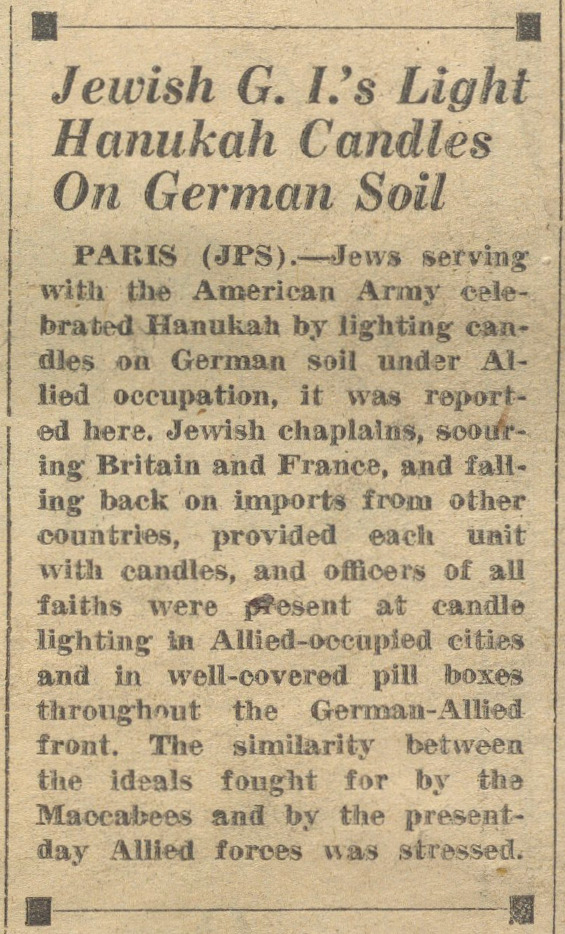
Hanukkah, 1944
Scenes from the liberation of Europe: Germany...
(Above, from the B'nai B'rith Messenger (Los Angeles), December 15th, 1944.)
...and Italy
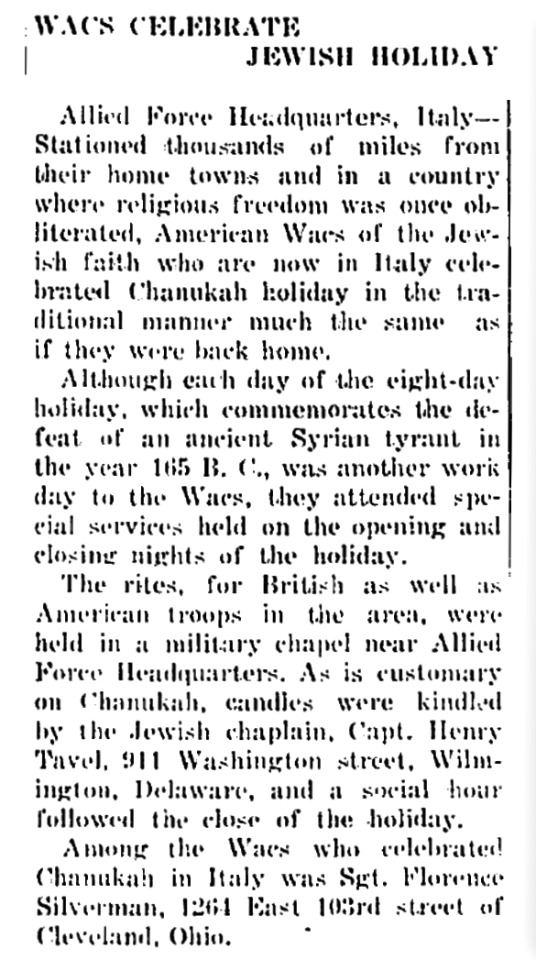
(From the Jewish Review & Observer (Cleveland), January 12th, 1945)
Chaplain Tavel was born in Cincinnati, Ohio, in 1905. He graduated from the University of Cincinnati before receiving his ordination from Hebrew Union College, also in Cincinnati, in 1929. Prior to his induction in July 1942 he served Congregation Beth Emeth, in Wilmington, Delaware. By late 1945 he had been promoted to Major and awarded the Bronze Star. Remaining in the Army until 1960, he later earned a Commendation Ribbon with pendant. After retiring he served the Congregation for Reform Judaism, in Houston, Texas, and was the author of several books. He died in 1969.
7 notes
·
View notes
Text


Hanukkah, 1944
Scenes from the liberation of Europe: Belgium
That letter was published in The Sentinel (Chicago) on January 4th, 1945. I hope that Warrant Officer Katzof was able to avail himself at some point of the the resource described below, in the following day's issue of The Jewish Chronicle (London):

4 notes
·
View notes
Text

Hanukkah, 1944: Broadcasting
Above, a page from Radio Times' issue of December 1st, 1944. There was a special Hanukkah broadcast on the Forces Programme.

It was only five minutes long, as you can see, and although it was repeated a week later there was nothing on the Home Service that year.
As at the High Holy Days, I found almost nothing from American broadcasters either. What I did find, though, was heartwarming, if only to me. It was highlighted in The Jewish Journal of Northern California's December 15th issue:

The personal angle here is that, 16 years later, Rabbi Burstein married my parents. His son and my father had been roommates at the University of California, and remained close friends for the rest of their lives.
6 notes
·
View notes
Text
Hanukkah, 1944: Anglo-American relations on both sides of the Atlantic
From the Chicago Tribune, December 17th, 1944:

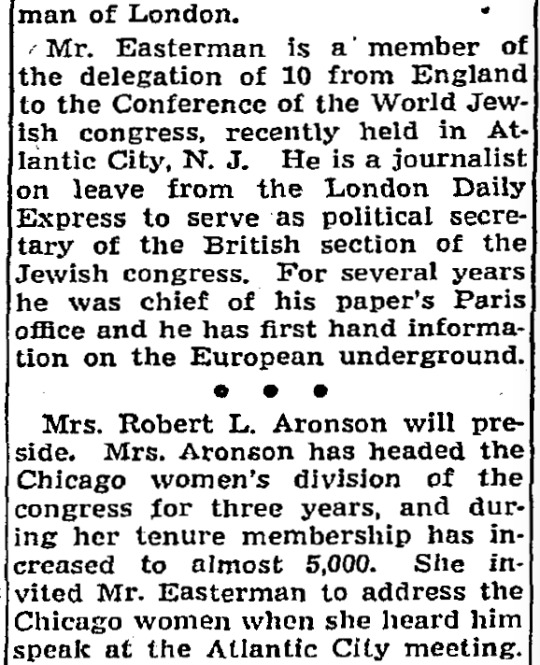
More about Alexander Easterman here.
And meanwhile, from The Jewish Chronicle, January 5th, 1945:

Captain Morton C. Fierman was born in Cleveland, Ohio, in 1914. He graduated from what is now Case Western Reserve University in 1935 and received his ordination in 1941 from Hebrew Union College. He briefly served as assistant rabbi at the Washington Hebrew Congregation, in Washington, D.C., before joining up at the end of 1942. He was discharged in 1946. He moved around quite a bit during the immediate post-war years, serving congregations in Missouri, Oklahoma, Arizona, and California before leaving the pulpit for higher education: from 1963 until he retired in 1981 he was a professor of religious studies at California State University Fullerton. He died in 1995.
I haven't been able to learn much about Captain Hirsch E. L. Freund. He was born in Poland in 1898 and came to the U.S. in 1911. He graduated from the University of Cincinnati in 1927 and received his ordination from Hebrew Union College the following year. Prior to his induction in 1942 he served Temple Judah in Cedar Rapids, Iowa, and he apparently spent some time in Indiana before that. He was still in the Army in 1946. During the late 1940s and early 1950s he worked for the Synagogue Council of America, and at some point was a chaplain at the U.S. Merchant Marine Academy, but that's all I know.
2 notes
·
View notes
Text
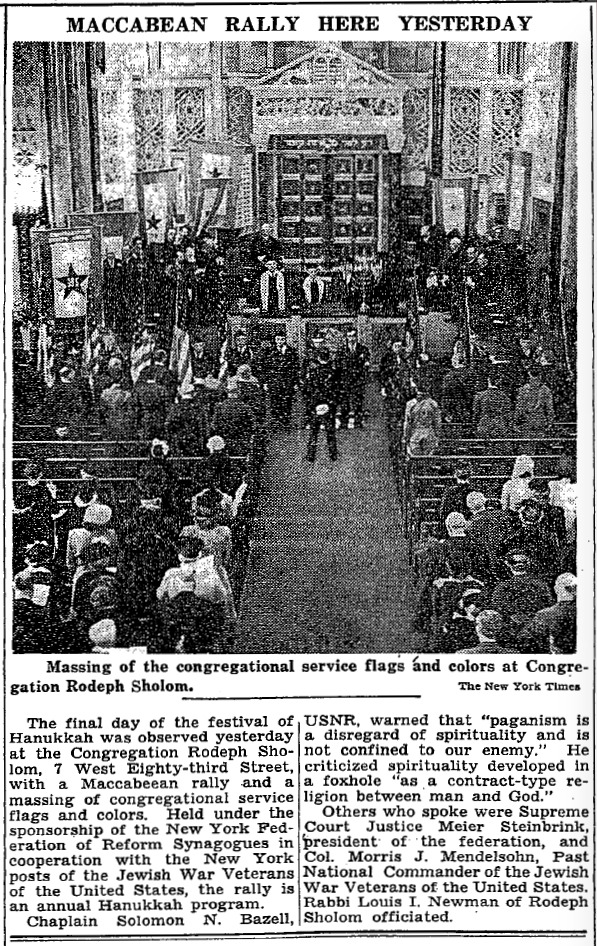
Hanukkah, 1944: Civil religion in New York City, London, and Nottingham
Above, from The New York Times, December 18th, 1944.
Lt. s.g. Bazell (1901-1963), a Reform rabbi, was born in Russia and was brought to the United States as an infant. He graduated from the University of Cincinnati, and received his ordination in 1923 (they were ordained really young in those days) from Hebrew Union College. Prior to induction in 1943 he served Temple Brith Sholom in Louisville, Kentucky. I've been unable to trace his post-war career; he seems to have been still in the Navy in late 1945. His son Haskell Bazell, a lawyer, was our neighbor in Berkeley, California, when I was an infant, and remained a good friend after we moved to Chicago. We lost touch at some point.
When I first moved to New York City in 1996 I lived just a few minutes' walk from Congregation Rodeph Shalom, and visited while "synagogue shopping." Even at a higher resolution, this photograph would hardly begin to do justice to the beauty of that sanctuary, and the music was excellent at the time. I found the overall atmosphere a bit chilly, however, and kept looking.
Meanwhile, in London, both the West London Chronicle on December 8th (above) and the Middlesex Independent and West London Star on December 9th carried notices for what was no doubt an interesting service...
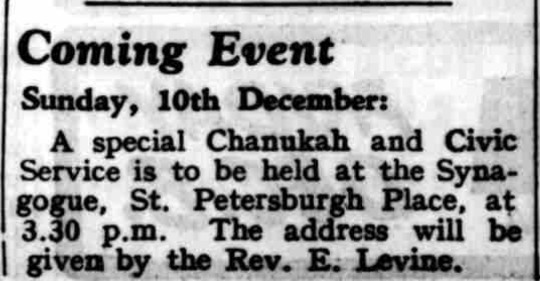

...but I haven't been able to find any coverage of the event itself.
That wasn't the case in Nottingham, where the Nottingham Journal both announced a local service on December 9th...

...and reported on it (and what followed) on December 11th:
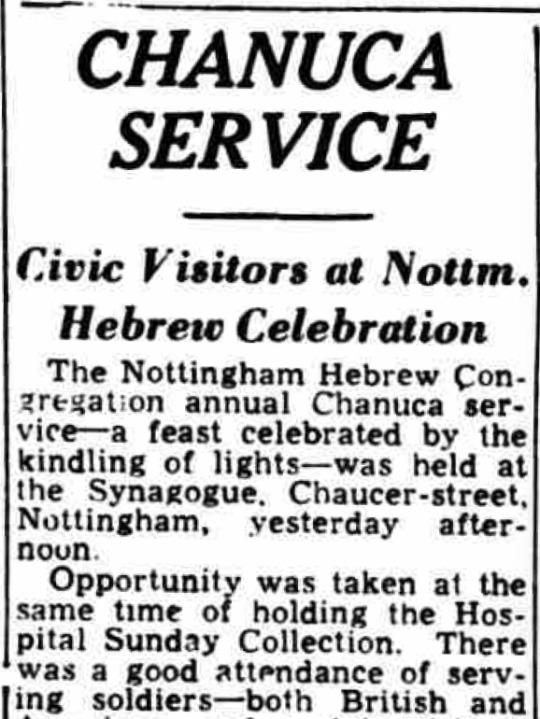
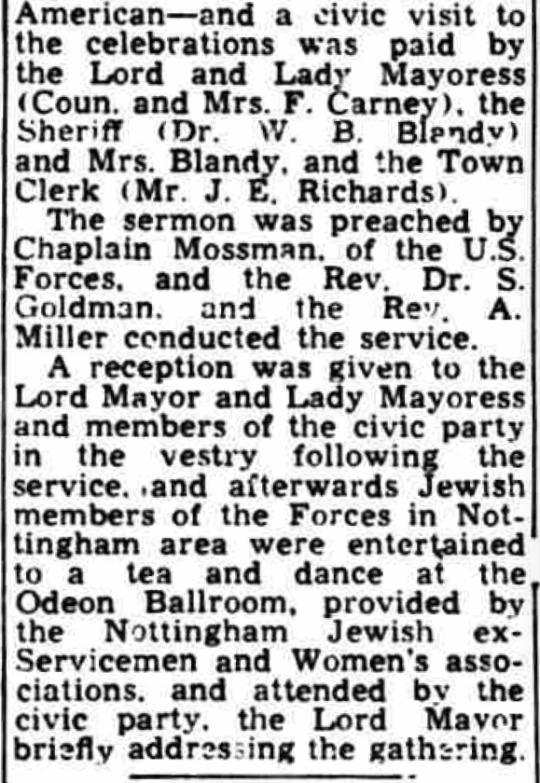
Captain Sidney K. Mossman, an Orthodox rabbi, was born in Canada in 1913 and came to the United States in 1930. In 1936 he graduated from DePaul University, here in Chicago, with a Bachelor of Laws degree (a credential that no longer exists); just two years later he received ordination from Hebrew Theological College, then in Chicago and how in Skokie. Prior to joining up in 1943 he served Congregation Knesseth Israel in Hammond, Indiana. He was still in the Army in late 1945; once again, I've been unable to trace his post-war movements.
(All images except the first are ©The British Library Board. All Rights Reserved.)
2 notes
·
View notes
Text


Hanukkah, 1944: Wartime or not, decent standards will be maintained!
All of these notices come from The Jewish Chronicle's issue of December 8th, 1944. All of the services they announce are choral. That's fantastic! 😃 But since all of the synagogues listed are Orthodox, that means all-male choirs, so the question is: with the boys evacuated and the men off at war, how did they manage this at the end of 1944?
2 notes
·
View notes
Text
Hanukkah, 1944

Putting this series of posts together has been challenging. Not that I had trouble finding material. On the contrary, I have more than I can use! But my usual topics — the U.K. home front, American troops overseas, civil religion, the liberation of Europe and, in particular, topicality — all seem to merge and overlap at this stage of the war.
To begin, here's some coverage of a subject that didn't seem to get very much of it during the war: refugees in the United States. This is from the New York Herald Tribune, December 11th, 1944. Hanukkah began in that year at sundown on December 10th, a Sunday.
2 notes
·
View notes
Text
Hanukkah, 1944
Scenes from the liberation of Europe (as viewed from the U.S.): France

Above, from the Indiana Jewish Post & Opinion, January 5th 1945.
And from The Jewish Journal of Northern California, December 29th, 1944:

0 notes
Text
In 1945, Purim began at sundown on February 26th, a Monday.
This year, that doesn't do me a bit of good.
Five and a half years ago, when I began my project of tracing the Anglo- (and, later, American-) Jewish WWII experience by examining holiday observances, I felt fortunate that the holidays fell on nearly same Gregorian-calendar dates during the war as they did in the year in which I was posting (as here, for example).
My luck in that department has now run out: Purim begins on Saturday, March 23rd. (That's right: the day itself will also be Palm Sunday! I should tell you that, historically speaking, things have been known to get ugly when Purim falls during Holy Week.) And what follows from that, of course, is that this will be one of the rare years in which Passover doesn't coincide with Easter, which may mean that we'll all have to do double duty on the Christian "Seder" watch.
Anyway, as this project draws to a close, I've decided to do my holiday posts on the days on which they fall this year, rather than when they fell in 1945. However, I thought that it might be useful — and interesting, I hope — to offer an explanation of why the holidays seem to slide around in this way.
The Jewish calendar is basically lunar, in that each new month begins with the new moon. There's a problem with this, however. On the one hand, 12 lunar months are about 11 days shorter than the solar year. On the other, the three major festivals — Sukkot, Pesach (Passover), and Shavuot — are all tied to the agricultural cycle. That might not be literally true today, but certainly Passover is associated with the coming of Spring, and so on. And Hanukkah takes on added resonance from the fact that it involves eight nights of lighting more and more candles at the time of year when the nights are getting longer and longer. Rely on a purely lunar calendar for for a few years, and things are going to get out of whack.
Our solution to this is to insert an extra lunar month in the 3rd, 6th, 8th, 11th, 14th, 17th, and 19th years of the Metonic cycle, creating a leap year (shanah me'uberet, literally a pregnant year). The added month comes in between the months of Adar and Nisan and is called Adar Sheini (Second Adar). In a common year, Purim is Adar 14th; in a leap year, it's Adar Sheini 14th. This year, 5784 — year eight of the cycle — is a leap year; 5705 (year five), which fell in 1944-45, wasn't. (No, I didn't do the math myself. Of course I didn't! Please.)
All of this was codified around 350 C.E. There's more information about that here.
2 notes
·
View notes